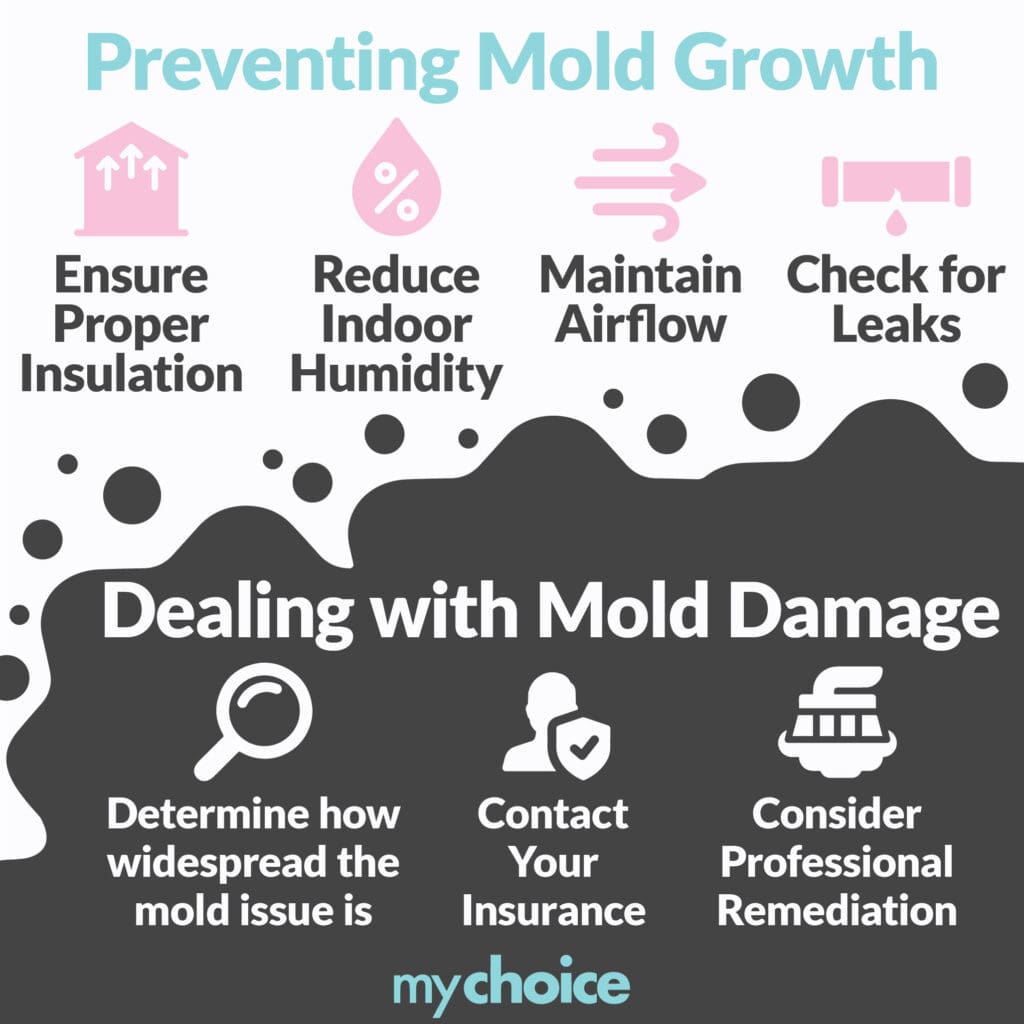Mould is a serious danger to your health, causing respiratory problems like congestion and worsening existing conditions like asthma. It can also severely damage your property, resulting in expensive repairs. You may think your home insurance policy covers mould removal and remediation, but unfortunately, this isn’t always the case.
Wondering if there are situations where home insurance does cover mould? Learn why mould is typically excluded from home insurance policies, how to prevent mould infestations, and what factors affect the cost of removal and remediation.
Why Is Mould Excluded by Standard Home Insurance Policies in Canada?
Mould infestations are usually excluded from standard home insurance policies because they can be prevented by regular home maintenance and proper upkeep. If there’s mould in your home, your home insurer will likely consider it a problem caused by neglect and will consider you financially responsible for remediating it.
Note that this doesn’t apply if the mould was caused by a peril covered by your home insurance policy. For example, if a storm damages your home and the moisture results in mould forming in your home, you may not be considered at fault and it may be covered by your insurer.
A Guide to The Insurance Claims Process for Mould Damage
If your mould infestation was caused by a covered peril on your home insurance policy, you can file a claim with your Canadian home insurer to partially or even wholly cover the cost of repairs and remediation. Here’s how to successfully navigate the typical claims process for mould damage:
- Thoroughly document the mould damage: Take videos and detailed photographs of the infestation and all affected areas to show the extent of the mould growth.
- Notify your home insurer: Policies limit when you can file claims, so inform your provider as soon as you discover the issue. Be persistent but polite when communicating, and keep detailed summaries of any conversations you have with representatives so you can remember requirements and questions.
- Prepare to explain why the mould was caused by an insurable risk: Prepare any relevant information about the cause of the infestation. Emphasize why it was caused by that risk and not by a lack of proper home maintenance.
- Hire a professional, certified mould removal and remediation company to test the mould, clean up, and prepare a report: Their pre and post-cleaning assessment should include details about the cause and extent of the infestation, as well as recommended remediation steps.
- Collect all your documentation and submit it along with your completed claim form to your insurer: Don’t forget to include the mould test results, your videos and photos, and the assessment from the mold remediation company.
- Wait for the results and appeal if needed: If your initial claim is rejected, try appealing the decision. If this fails, you can contact the Insurance Bureau of Canada for further advice and a third-party opinion on your claim that may reverse the rejection.
Tips to Prevent Mould Growth
You can prevent mould from growing in your home by maintaining a clean, dry, and airy environment. Here are some effective tips you can try to keep your house mould-free and protect yourself and your loved ones:
- If you’re renovating or building a new home, use mould-resistant materials: Many materials such as insulation, drywall, and paint come in mould-resistant versions. Consider using these to reduce the risk of mould growth, especially for areas that are likely to get wet.
- Ensure that your home is properly ventilated: Adequate ventilation will keep humid air from being trapped, preventing mould infestation. Open your windows so fresh air circulates throughout your home and make sure your HVAC vents aren’t blocked.
- Clean up leaks and puddles immediately: Mould can develop in as little as 24 to 48 hours, so dry any wet areas or standing water in your home.
- Reduce dampness year-round with a dehumidifier: Use a dehumidifier with automatic sensors to measure your home’s humidity levels and remove excess moisture.
- Keep outside moisture from entering your home: Regularly clean and repair your roof and ensure rainfall is directed away from your house. Prevent puddles from forming near your home’s foundation and entering through hidden cracks.

Mould Removal Costs and Remediation Services
The cost of removing mould from your home depends on the severity of the infestation, which is affected by the following factors:
Services that may be part of the mould removal and home remediation, depending on the provider, include:
- Cleaning and disinfecting
- Removing mouldy, water-damaged materials
- Pre-removal air testing to determine the type of mould and spore concentration
- HEPA filtration during and after remediation
- Repairing or replacing mould-damaged materials, such as paint and wood
- Conducting post-remediation inspections and providing reports to confirm that your home is mould-free
The average cost of mould removal in Canada ranges from $2,000 to $6,000, but can go up to triple the regional average cost if there’s extensive damage, a large infestation, or the type of mould is difficult to treat. Early treatment is key to lower removal costs, so book professional services immediately if you notice mould in your home.
Key Advice from MyChoice
- Make sure you hire a certified and reputable mould remediation company to remove your mould infestation. Check for proper licensing, ask for references or search for them online, and get detailed estimates so you get the best possible service for your money.
- Some insurers offer mould insurance as an add-on. Consider getting this extra coverage option if you’ve dealt with mould issues in the past or live in a mould-prone, humid area.
- Note that regardless of infestation size, some types of mould are more challenging to remove and can cause health risks without the proper precautions. If you spot mould in your home, hire professional services to remove and remediate the area ASAP to prevent further spreading and make your home’s air safe to breathe again.








